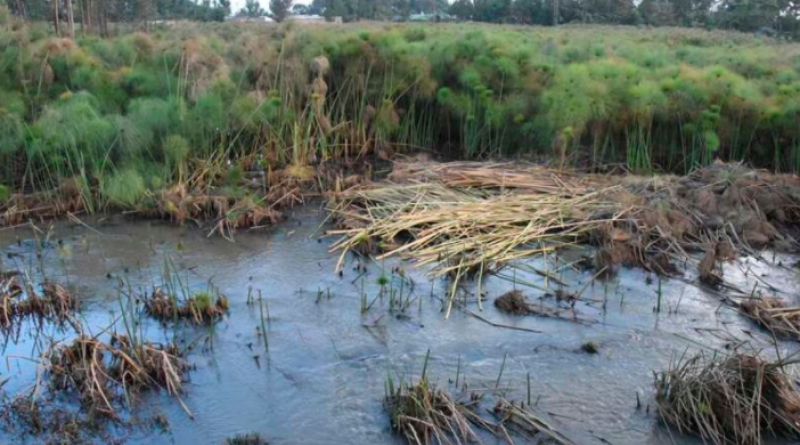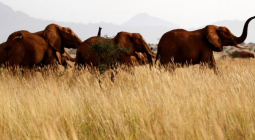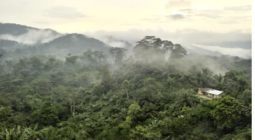Bottlenecks in conserving critical wetlands in Kenya.

From swamps, lakes, rivers, riparian land to sandy beaches, the wetlands are vital in the provision of clean water, health, tourism and agricultural sectors.
But the wetlands are under threat from human activities as a result of pollution and encroachment due to population growth and effects of climate on the riparian and water bodies. Environmentalists and other stakeholders are concerned over the lack of harmonious enforcement of conservation laws, posing a threat to the conservation of the endangered wetlands in the country.
In a report titled the State of Wetlands in Kenya by the National Environmental Complaints Committee, the environment ombudsman singles out some of the constraints as legal and policy vacuums, uncoordinated implementation of sectoral plans, inadequate information base and low community participation in wetland management for endangering them.
According to Philip Raburu, a lead wetlands researcher, despite Kenya having robust laws and policies, there is an urgent need to harmonise policies to foster enforcement in the protection of the wetlands.
In Kenya, the legal frameworks on wetland management include the Constitution, Environmental Management and Co-ordination Act 1999, Forest Conservation and Management Act 2016, Wildlife Conservation and Management Act, 2016, Water Act 2016, Land Act, 2012 and National Land Commission Act 2012.
He says Kenya is endowed with laws, regulations and Acts. However, several State agencies have a different description of riparian land or zones and tend to work independently in managing the natural resource.
“Most of the livelihoods rely on agriculture so you find Ministry of Agriculture has its particular description on riparian land to be protected, same as Ministry of Water or Water Resource Management Authority, which has a different way of classifying riparian zones. Nema (National Environment Management Authority) also has different ways of describing the zones like riparian, which bring a lot of conflicts when it comes to managing these resources,” explains Prof Raburu, who is also deputy vice-chancellor in charge of planning, research and extension at University of Eldoret.
In Kenya, some of the internationally designated sites for protection under the Ramsar Convention include the Tana River belt, Lake Olbosat, Lake Nakuru, Lake Bogoria, and Lake Naivasha due to its national importance.
However, experts worry that these wetlands continue to face numerous challenges due to poor enforcement.
Unlike Uganda that has established a fully-fledged department in charge of the wetlands, Kenya lacks a centralised unit to oversee the management of wetlands, hindering conservation efforts.
The experts recommended the harmonisation of these bodies to strengthen the protection of these critically endangered natural resources. For instance, the Kenya Wildlife Service in charge of the protection of wetlands in the protected areas like national parks while Nema manages wetlands and licensing of any projects in all areas, including those considered wetlands.
“The conflicts arise in terms of who is doing what. Generally, there is an understanding that all the wetlands should be protected...The policies are there but the division of labour is hurting the enforcement efforts that why these bodies need to be harmonised so that we seamlessly protect these wetlands in the country,” said Prof Raburu during the second national conference on wetlands in 30 years that brought together key policymakers, researchers and other stakeholders.
On May 12, the University of Eldoret organised the first national conference on wastelands in the country that brought together various stakeholders in the sector. The last time, Kenya hosted such a forum was in 1992.
Prof Raburu expressed regret that institutions of higher learning lack research materials as reference tools for academic scholars and wetland managers.
“There is no single standard book authored by Kenyans on wetlands despite numerous studies in the past, we expected to get 60 abstracts but we have received 90 abstracts.
From the research papers we are receiving, they will help in coming up with books and policy framework to guide the better management of the wetlands,” he says.
Although there is no official data on the exact size of wetlands, various data varies on the same. It is estimated that wetlands cover three to five percent of the land, depending on the seasons.
Currently, various State agencies and Kenyan university researchers have embarked on mapping all natural resources including the wetlands to develop a national natural resource atlas.
“Several governmental agencies such as the commission are currently working on the report and it is expected to be completed within the next two months. Wetlands have been pushed to the periphery but science is telling us otherwise that they are critical ecosystem and we should conserve for them,” said Reginald Okumu, a commissioner at National Land Commission.
He says there is a need to adopt scientific research to develop natural resources management policies.
“For long they have been seen as an impediment to the development but science tells us that we need to conserve them. We need to put proper policies to protect wetlands for the benefit of current and future generation,” says Mr Okumu.
He says the Constitution recognises the wetlands as public land but silent on how the local communities can utilise the natural resources, sustainably. Due to a lack of clarity on the law, communities in the wetlands often find themselves living as squatters.
“Although, in the past, wetlands have been considered unallocatable...there is no classification on whether they are community or government land, unlike forests. With the 2010 Constitution, forests were clearly identified as either community or public but this did not happen to wetlands,” argues Mr Okumu.
The international conventions and Kenyan Constitution protect the rights of the communities living adjacent to the wetlands and advocate for the sustainable use of natural resources for the benefit of all the citizens.
“Unlike forests where it is clearly defined as public or community, this did not happen to wetlands. It becomes very difficult to grant access or protect the rights of these communities like other communities in terms of community forests and I think this need to be rectified,” says the land policy expert.
Despite Kenya being a signatory of the Ramsar Convention, the wetlands face threat from human activities such as pollution.
In designating a wetland as a Ramsar site, countries agree to establish and oversee a management framework aimed at conserving the wetland and ensuring its wise use.
Wise use under the convention is broadly defined as maintaining the ecological character of a wetland.
Wetlands can be included on the List of Wetlands of International Importance because of their ecological, botanical or zoological importance.
And even as the law spells out the elaborate conditions on how to allocate public land to an individual, there are no such tools in environmental conservation.
“The existing conditions are oriented towards built-environment or agriculture. But when it comes to environmental conservation, there are no specific tools that can be used...We are hoping scientists will guide us in coming up with these tools such as climate-smart to be included when issuing orders or leases,” said Mr Okumu.
The Environmental Management and Co-ordination Act 1999 defines wetlands as areas permanently or seasonally flooded by the water where plants and animals have become seasonally adapted.
Dr John Chumo, Committee Secretary at National Environmental Complaints Committee (NECC) argues that the various devolved units ought to pool funds to aid implementation of wetlands management plans to protect them.
“Counties should develop management plans for all wetlands. Local communities must be brought on board in the management and rehabilitation of wetlands,” adds Dr Chumo.
Charles Oluchina regional program coordinator at International Union for Conservation of Nature (IUCN) says that the effects of climate change had presented an opportunity to promote use of green bonds, carbon credit and development of climate-smart innovations by scientists to protect the wetlands.
Environment PS Dr Chris Kiptoo, who chaired inter-ministerial committee to establish the reason behind the rise water volumes in lakes, says that wetlands are under threat due to human activities, deforestations and climate change.
During the conference, he says that the government had developed robust laws and policies and called for collective responsibility in protecting and conserving the wetlands that is source for raw materials for medicine, food and clean water.
18 May 2021
Business Daily




